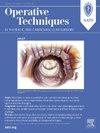The Ventricular Switch Procedure Atlas: Adopting the Right Ventricle for the Systemic Circulation
Q3 Medicine
Operative Techniques in Thoracic and Cardiovascular Surgery
Pub Date : 2025-06-01
DOI:10.1053/j.optechstcvs.2024.07.007
引用次数: 0
Abstract
Patients born with complex heterotaxy syndromes and patients with complex intra-cardiac connections are generally routed to univentricular pathways. This subgroup of patients typically carries poor long-term prognosis due to the frequent presence of unpartitioned atrioventricular valve and other morphological determinants that are associated with univentricular failure. Adopting the left ventricle in the systemic circulation would be the ideal choice if achievable. However, the presence of complex venous or arterial connections may make this infeasible. To overcome these limitations, we have introduced the concept of the “Ventricular Switch Procedure” (VSP) wherein the right ventricle is harnessed to serve as the systemic ventricle, while utilizing the left ventricle for the subpulmonary ventricle. The VSP paradigm offers prospect of a either a one-and-a-half or biventricular circulation for these patients. Here, we present 4 examples of complex congenital cardiac malformations and their surgical management to exemplify the principles of this surgical concept and illustrate how different techniques may be employed to achieve a right ventricle-based biventricular circulation.
心室开关程序图集:采用右心室进行体循环
先天性复杂异位综合征和心脏内连接复杂的患者通常会进入单室通路。由于房室瓣不分割和其他与单心室衰竭相关的形态学决定因素的存在,这类患者通常具有较差的长期预后。如果可行,在体循环中采用左心室将是理想的选择。然而,复杂的静脉或动脉连接的存在可能使这种方法不可行。为了克服这些限制,我们引入了“心室转换程序”(VSP)的概念,其中利用右心室作为系统心室,同时利用左心室作为肺下心室。VSP模式为这些患者提供了一个半或双心室循环的前景。在这里,我们提出了4例复杂的先天性心脏畸形及其外科治疗的例子,以举例说明这种外科概念的原则,并说明如何使用不同的技术来实现以右心室为基础的双心室循环。
本文章由计算机程序翻译,如有差异,请以英文原文为准。
求助全文
约1分钟内获得全文
求助全文
来源期刊

Operative Techniques in Thoracic and Cardiovascular Surgery
Medicine-Surgery
CiteScore
1.40
自引率
0.00%
发文量
59
期刊介绍:
Operative Techniques in Thoracic and Cardiovascular Surgery provides richly illustrated articles on techniques in thoracic and cardiovascular surgery written by renowned surgeons. Each issue presents cardiothoracic topics in adult cardiac, congenital, and general thoracic surgery. Each specialty of interest to the thoracic and cardiovascular surgeon is explored through two different approaches to a specific surgical challenge. Each article is thoroughly illustrated with original line drawings, actual intraoperative photos, and supporting tables and graphs.
 求助内容:
求助内容: 应助结果提醒方式:
应助结果提醒方式:


